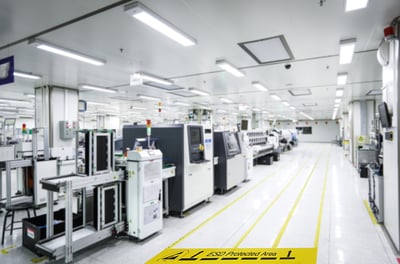
Manufacturers often want to improve the scratch-resistant of a base material surface to improve overall application performance. Some application examples would include automotive parts, industrial lighting components, sporting goods, optical medical applications, aerospace components, and materials optimized for a harsh environment. Shifting the scratch resistance of these materials produces better quality, more reliable products.
 The process of coating a thermal sensitive part with a scratch-resistant coating is performed under vacuum in a vacuum chamber. Parts are first placed in a vacuum chamber and pumped down to remove the residual air from the chamber. Process gas is added to the vacuum chamber at a controlled rate to flush out all remaining air and establish a gas flow at low pressure to produce plasma. Plasma is generated in the chamber of gas and parts by adding RF energy to the chamber. After the plasma cleaning and activation process, RF energy and process gas are stopped, and the chamber is pumped down to remove all plasma cleaning gas from the chamber.
The process of coating a thermal sensitive part with a scratch-resistant coating is performed under vacuum in a vacuum chamber. Parts are first placed in a vacuum chamber and pumped down to remove the residual air from the chamber. Process gas is added to the vacuum chamber at a controlled rate to flush out all remaining air and establish a gas flow at low pressure to produce plasma. Plasma is generated in the chamber of gas and parts by adding RF energy to the chamber. After the plasma cleaning and activation process, RF energy and process gas are stopped, and the chamber is pumped down to remove all plasma cleaning gas from the chamber.
At this point, scratch-resistant coating deposition is performed by introducing a gas flow into the chamber to achieve a stable process pressure. Then RF energy is added to the monomer gas feedstock to produce a deposition of a glass-like scratch-resistant coating. After the process is completed, the RF energy and gas are stopped, the chamber is flushed and vented. Coated parts are removed, and a process can start again.
 Scratch-resistant coatings in manufacturing can be achieved in a high-volume process. Using a plasma chamber to add a scratch-resistant coating can be applied to an entire three-dimensional part uniformly. Manufacturers can control the thickness of the coating to a high degree using this process. With a plasma-enhanced chemical vapor deposited coating, the hardness can be controlled by varying gas content during the process of mixing monomer vapor with other gases.
Scratch-resistant coatings in manufacturing can be achieved in a high-volume process. Using a plasma chamber to add a scratch-resistant coating can be applied to an entire three-dimensional part uniformly. Manufacturers can control the thickness of the coating to a high degree using this process. With a plasma-enhanced chemical vapor deposited coating, the hardness can be controlled by varying gas content during the process of mixing monomer vapor with other gases.
This method of coating has many manufacturing advantages over other coating methods, which include low process temperature for thermally sensitive materials, low-cost feedstocks, easy handling of materials, and ease of chemistry dosing method due to the low vapor pressure of process monomer, no exposure to spraying processes, and no high-temperature ovens to cure a hard coat.
There are other benefits of these scratch-resistant coatings. One other benefit is that the coating provides a barrier to gas permeability. Benefits will also include high electrical insulation, additional chemical resistance, and increased UV protection for the parts with the coating applied.
Although this scratch-resistant processing method has all the benefits mentioned above, it takes a generous amount of experience and the right plasma processing equipment configuration to optimize the coating composition for thickness, hardness, adhesion, internal stress, and impedance. Skilled plasma processing professionals have learned how to optimize this process to create high-quality and repeatable manufacturing production lines. These scratch-resistant coatings can also be added as an adhesion promoter layer for other bonding processes.
Many manufacturers need to coat their thermally sensitive materials with a scratch-resistant coating. Low-temperature plasma-enhanced chemical vapor deposition is an excellent method to provide all the benefits that are reviewed in this article. Equipment for scaling these processes to support high-volume manufacturing applications is available. The application of applying a non-thermal scratch-resistant coating utilizing plasma enhanced chemical vapor deposition is a proven technology that can be applied to your materials and process applications today.
Interested in learning more about how coatings enable manufacturers to improve the quality of their products? Please consider downloading our eBook titled "The Manufacturer's Plasma Coating Playbook" to learn about scratch resistant surfaces and other coating applications. If you are interested in speaking to an expert in plasma applications, please consider reaching out and scheduling a plasma treatment overview discussion.
Comments